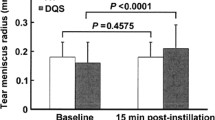Abstract
This study aimed to compare the effects of treatment with punctal plugs versus artificial tears on visual function and tear film stability for dry eye. A total of 56 consecutive eyes of 28 dry eye patients observed at our clinic from May to October in 2009 were divided into two groups. One group (32 eyes of 16 patients) was treated with artificial tears, and punctal plugs were used in the other group (24 eyes of 12 patients). A questionnaire was used in these patients before treatment and was repeated 2 weeks after treatment. Fluorescent staining for tear film break-up time (BUT), the Schirmer test I (STI), and contrast sensitivity was performed at the same time. The questionnaire indicated that all patients complained about the uncomfortable symptoms associated with dry eye. These symptoms were relieved after the application of artificial tears or punctal plugs, and there was no significant difference between these two groups. We found that the corneal fluorescent staining disappeared after treatment. The BUT was improved significantly after treatment in both groups, but the improvement was greater in patients who received punctal plugs than those that received artificial tears. There was no remarkable change in the STI in the artificial tears group, but a significant change was observed in the punctal plugs group. The contrast sensitivities were greatly improved in simulated daylight, night, and glare disability conditions after treatment with artificial tears and punctal plugs. However, the changes in contrast sensitivity did not significantly differ between groups. Both artificial tears and punctal plugs relieved dry eye symptoms, repaired corneal lesions, enhanced tear film stability, and improved contrast sensitivity. Punctal plugs could improve tear film stability and elongate the BUT better than artificial tears.
Similar content being viewed by others
References
Huang FC, Tseng SH, Shih MH, Chen FK. Effects of artificial tears on corneal surface regularity contrast sensitivity and glare disability. Ophthalmology. 2002;109:1934–40.
Hitchcock EM, Dick RB, Krieg EF. Visual contrast sensitivity testing: a comparison of two F.A.C.T. test types. Neurotoxicol Teratol. 2004;26:271–7.
Gayton JL. Etiology, prevalence, and treatment of dry eye disease. Clin Ophthalmol. 2009;3:405–12.
Liu Z, Pflugfelder SC. Corneal surface regularity and the effect of artificial tears in aqueous tear deficiency. Ophthalmology. 1999;106:939–43.
Torkildsen G. The effects of lubricant eye drops on visual function as measured by the inter-blink interval visual acuity decay test. Clin Ophthalmol. 2009;3:501–6.
Goto E, Yagi Y, Kaido M, Matsumoto Y, Konomi K, et al. Improved functional visual acuity after punctal occlusion in dry eye patients. Am J Ophthalmol. 2003;135:704–5.
Toda I, Asano-Kato N, Komai-Hori Y, Tsubota K. Dry eye after laser in situ keratomileusis. Am J Ophthalmol. 2001;132:1–7.
Dursun D, Monroy D, Knighton R, Tervo T, Vesaluoma M, Carraway K, et al. The effects of experimental tear film removal on corneal surface regularity and barrier function. Ophthalmology. 2000;107:1754–60.
Rieger G. The importance of the precorneal tear film for the quality of optical imaging. Br J Ophthalmol. 1992;76:157–8.
Rieger G. Contrast sensitivity in patients with keratoconjunctivitis sicca before and after artificial tear application. Graefes Arch Clin Exp Ophthalmol. 1993;231:577–9.
Rolando M, Iester M, Macri A, Calabria G. Low spatial-contrast sensitivity in dry eyes. Cornea. 1998;17:376–9.
Paulsson LE, Sjöstrand J. Contrast sensitivity in the presence of a glare light. Theoretical concepts and preliminary clinical studies. Invest Ophthalmol Vis Sci. 1980;19:401–6.
Gilbard JP, Rossi SR, Azar DT, Heyda KG. Effect of punctal occlusion by Freeman silicone plug insertion on tear osmolarity in dry eye disorders. CLAO J. 1989;15(3):216–8.
Acknowledgments
This study was supported by Seed fund (no. 79495-01) and Linhu fund (no. 79495-02) of Peking University Third Hospital.
Conflict of interest
The authors report no conflicts of interest.
Author information
Authors and Affiliations
Corresponding author
Rights and permissions
About this article
Cite this article
Qiu, W., Liu, Z., Zhang, Z. et al. Punctal plugs versus artificial tears for treating dry eye: a comparative observation of their effects on contrast sensitivity. j ocul biol dis inform 5, 19–24 (2012). https://doi.org/10.1007/s12177-012-9094-x
Received:
Accepted:
Published:
Issue Date:
DOI: https://doi.org/10.1007/s12177-012-9094-x




